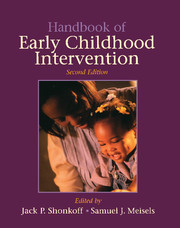Book contents
- Frontmatter
- Contents
- Foreword
- Preface
- Contributors
- PART ONE INTRODUCTION
- PART TWO CONCEPTS OF DEVELOPMENTAL VULNERABILITY AND RESILIENCE
- PART THREE THEORETICAL FRAMEWORKS FOR INTERVENTION
- PART FOUR APPROACHES TO ASSESSMENT
- PART FIVE SERVICE DELIVERY MODELS AND SYSTEMS
- 15 Preventive Health Care and Anticipatory Guidance
- 16 Early Care and Education: Current Issues and Future Strategies
- 17 Early Intervention for Low-Income Children and Families
- 18 Services for Young Children with Disabilities and Their Families
- 19 Early Childhood Mental Health Services: A Policy and Systems Development Perspective
- 20 Paraprofessionals Revisited and Reconsidered
- 21 Personnel Preparation for Early Childhood Intervention Programs
- PART SIX MEASURING THE IMPACT OF SERVICE DELIVERY
- PART SEVEN NEW DIRECTIONS FOR THE TWENTY-FIRST CENTURY
- Name Index
- Subject Index
20 - Paraprofessionals Revisited and Reconsidered
Published online by Cambridge University Press: 05 November 2011
- Frontmatter
- Contents
- Foreword
- Preface
- Contributors
- PART ONE INTRODUCTION
- PART TWO CONCEPTS OF DEVELOPMENTAL VULNERABILITY AND RESILIENCE
- PART THREE THEORETICAL FRAMEWORKS FOR INTERVENTION
- PART FOUR APPROACHES TO ASSESSMENT
- PART FIVE SERVICE DELIVERY MODELS AND SYSTEMS
- 15 Preventive Health Care and Anticipatory Guidance
- 16 Early Care and Education: Current Issues and Future Strategies
- 17 Early Intervention for Low-Income Children and Families
- 18 Services for Young Children with Disabilities and Their Families
- 19 Early Childhood Mental Health Services: A Policy and Systems Development Perspective
- 20 Paraprofessionals Revisited and Reconsidered
- 21 Personnel Preparation for Early Childhood Intervention Programs
- PART SIX MEASURING THE IMPACT OF SERVICE DELIVERY
- PART SEVEN NEW DIRECTIONS FOR THE TWENTY-FIRST CENTURY
- Name Index
- Subject Index
Summary
I think that it is a direct and personal service that I offer my clients. I live in the community I serve; I am available at all hours and on weekends. By living in the community, I am available to provide the same resources as is common in our middle-class communities which often have doctors, lawyers, and other professionals living next door to each other. Individuals such as myself have never been available for the poor community to take advantage of. I believe that my style of handling clients' problems who live in the poor community is the most effective way possible. I'm from the community I serve, I know most of the people, they know me. I know their problems because they are mine also, and I understand the poor people because I am one, and a part of them. (Specht, Hawkins, & McGee, 1968, p. 10).
This chapter examines the roles and effectiveness of staff in community-based, urban, early intervention programs in which the primary goal is improving the caregiving environment and the development of infants and young children considered at risk. In these programs, risk is defined as a consequence of any one, or a combination of, the following factors: growing up in a community with high rates of poverty, violence, crime, unemployment, and so forth; being raised by very young or troubled parents; or manifesting developmental problems or delays. Seldom are those charged with the task of modifying the caregiving environment professionally trained staff such as physicians.
- Type
- Chapter
- Information
- Handbook of Early Childhood Intervention , pp. 439 - 453Publisher: Cambridge University PressPrint publication year: 2000
- 8
- Cited by

